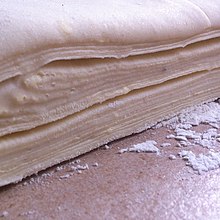
Laminated dough is a culinary preparation consisting of many thin layers of dough separated by butter or other solid fat, produced by repeated folding and rolling. Such doughs may contain more than eighty layers. During baking, water in the butter vaporizes and expands, causing the dough to puff up and separate, while the lipids in the butter essentially fry the dough, resulting in a light, flaky product.
Pastries using laminated doughs include:
- Croissant pastry, from France
- Danish pastry, made with yeast-leavened dough, from Austria via Denmark
- Flaky pastry
- Jachnun, a Yemenite Jewish pastry
- Kouign-amann, a sweet Breton cake from north-western France
- Kubaneh, a traditional Yemenite Jewish bread
- Malawach, a Yemenite Jewish flatbread
- Paratha, a flatbread native to South Asia
- M'semen, a traditional flatbread of northern Africa
- Puff pastry
See also
 Food portal
Food portal- Dough sheeting, an industrial preparation technique
- Filo pastry, used in applications such as baklava, strudel, and spanakopita, where the dough itself is not laminated
- Kâhi, an Iraqi dough can be mixed with cream and sugar syrup
References
- King, Andy; King, Jackie. "Laminated Dough: A Guest Post from Bakery Owner Andy King". King Arthur Flour. Retrieved 1 November 2014.
- Alton Brown (March 21, 2011). "A Bird In The Pie Is Worth Two In The Bush". Good Eats. Season 14. Episode 1416. 12 minutes in. Food Network.
- Rao, Tejal (22 June 2017). "Before Croissants, There Was Kubaneh, a Jewish Yemeni Delight". New York Times Magazine. Retrieved 3 July 2017.
This cooking article about preparation methods for food and drink is a stub. You can help Misplaced Pages by expanding it. |
This bread-related article is a stub. You can help Misplaced Pages by expanding it. |